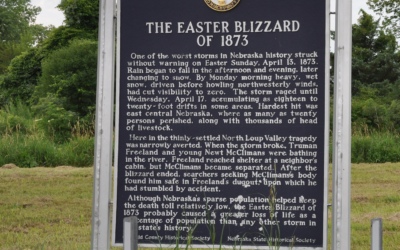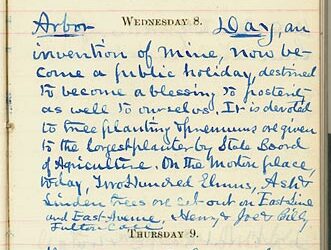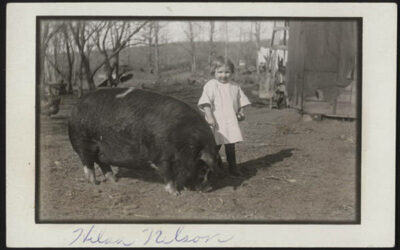By David L. Bristow
August 23, 2022
Three yards and a cloud of dust. Leather helmets. A forward pass with a ball that looks like a watermelon. A drop kick. Fans cheering from wooden bleachers that were later demolished to make way for Memorial Stadium.
Nebraska-Notre Dame was one of the hottest rivalries in college football in the 1910s and 1920s. These film clips from 1919 or 1920 show us what it looked like. (In the still above, Notre Dame players have numbers on the backs of their jerseys.)
The film, digitized by History Nebraska, includes a variety of campus scenes spliced together by the university in the 1920s. In fact, the Notre Dame footage is followed by an even earlier football clip from 1912-1914. We believe this is the earliest known film of Husker football.
Although there’s only 1:46 of football before the scene switches to Poet Laureate John G. Neihardt (!), there’s a lot here to notice.
How do we know when was the film made?
The film in our University of Nebraska Collection is a 16mm copy of the original 35mm film. The film is said to contain footage of an NU-Notre Dame game, but no year is given. Notre Dame played at Nebraska Field every year from 1914 to 1920 and again in 1922.
The first 55 seconds of the film shows various clips from what looks like the same game. Nebraska’s uniforms lack stripes, so it can be no earlier than 1919. Also, the bleachers are adorned with strings of flags and pennants—not the case in known photos of the 1922 Notre Dame game.
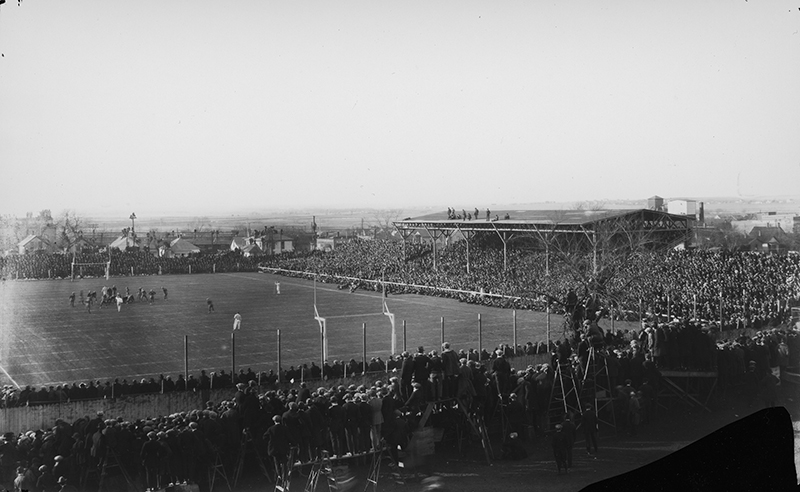
Nebraska vs. Notre Dame at Nebraska Field, November 30, 1922. RG2758-105-10
Photos from the annual Cornhusker yearbooks are small and not always labeled, but pennants are visible in photos of the 1919 season and (apparently) not in 1920. So this is probably 1919.
The scene shifts at the 55-second mark. Now we see the team trotting onto Nebraska Field wearing stripes on their sleeves and socks. The only years during the Nebraska Field era when the Huskers wore such uniforms were 1912-1914.
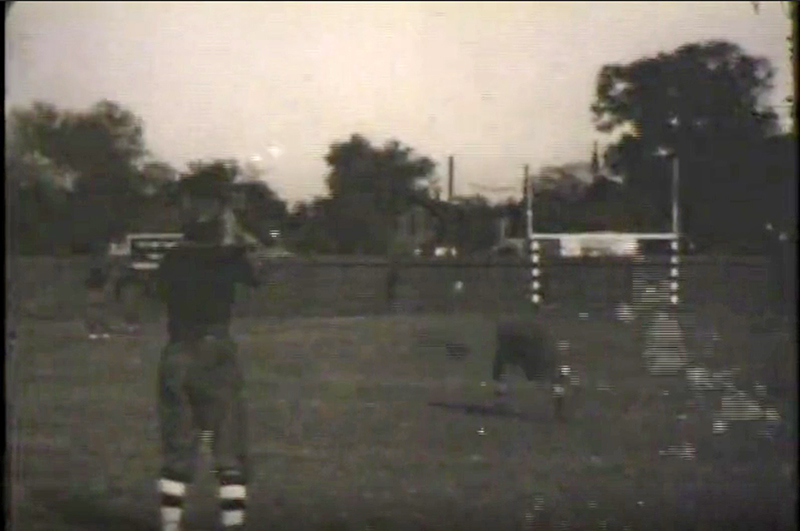
From the game film: snapping the ball for a drop kick, circa 1912-1914.
 From the 1914 Cornhusker yearbook.
From the 1914 Cornhusker yearbook.
To me, the best part of this older clip is at 1:06 when the camera is on the field—apparently during warm-ups—and we see a Husker player do a drop kick, a forgotten part of the game that was common before the ball became longer, slimmer, and pointy at the ends in the 1930s. The drop kick remains a regular part of rugby.
Nebraska first played Notre Dame in 1914, but the older clip probably isn’t from that game—too few fans! The Notre Dame series was a big deal for Nebraskans from the start.
Notre Dame at Nebraska, 1919
Let’s look closer at the film’s first 55 seconds. Notice all the dust? If this is indeed the 1919 game, that’s sawdust being kicked up with every step. To prevent a muddy field in case it rained, that year Nebraska officials coated the entire field with a layer of sawdust before the game. Nebraska officials also hoped the sawdust would soften the field’s “asphaltic surface” and prevent injuries. Notre Dame coach Knute Rockne and his staff were skeptical enough that they swept part of the field with brooms before practicing there on the Friday before the big game.
This photo shows a clearer view of the bleachers shown at 0:05. This photo isn’t dated, but look at the dusty foreground. Is this from the 1919 Notre Dame game?
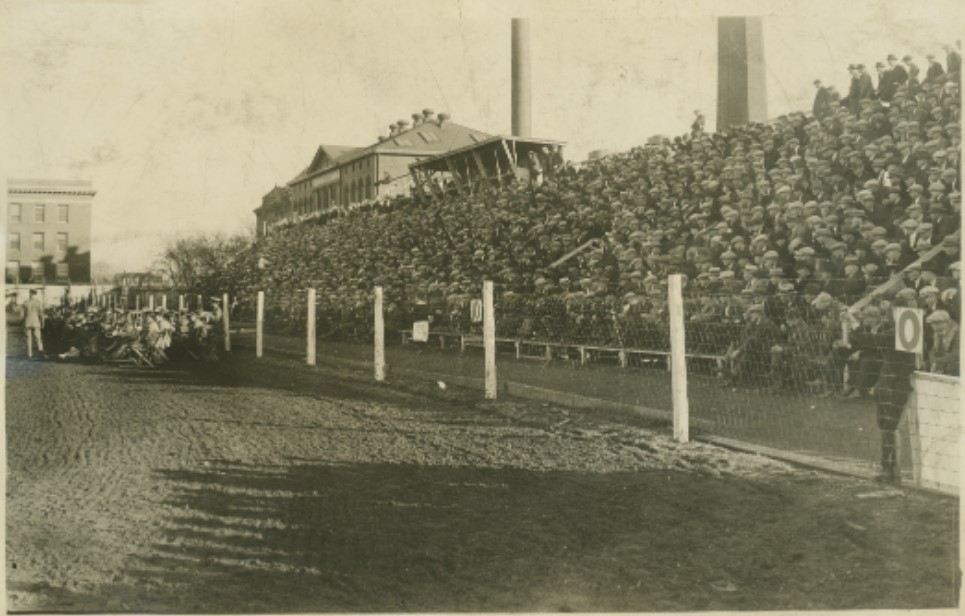 Nebraska Field was on the present site of Memorial Stadium, but the field ran east-west instead of north-south. The view here is to the east-southeast along the south bleachers, just south of present South Stadium. The back of Avery Hall (minus a later addition) is visible at left. The building at rear center is Mechanic Arts Hall, on the current site of Manter Hall. RG2758-105-7
Nebraska Field was on the present site of Memorial Stadium, but the field ran east-west instead of north-south. The view here is to the east-southeast along the south bleachers, just south of present South Stadium. The back of Avery Hall (minus a later addition) is visible at left. The building at rear center is Mechanic Arts Hall, on the current site of Manter Hall. RG2758-105-7
Nebraska expected a tough game—Notre Dame was once again among the nation’s top teams. Nebraska, meanwhile, had opened the season with a loss (Iowa) and a tie (Minnesota), both on the road. Nebraska Field welcomed a capacity crowd—about 8,000 fans—for the home opener on October 18.
Notre Dame struck quickly. According to the Nebraska State Journal, star player George Gipp received the opening kickoff on the three yard line and “tossed the oval aside as he would have tossed a cigaret.” A teammate returned the ball 97 yards for a touchdown. The Journal dismissed this as a “prep-school trick.”
To hear the Journal and other papers tell it, Nebraska outplayed Notre Dame in “straight football,” outrushing the “Catholics” 106 yards to 55. But Notre Dame beat Nebraska with its effective use of the forward pass.
The forward pass wasn’t new—it had been legalized in 1906 to “open up the game” at a time when a growing number of players were being killed or severely injured. Notre Dame rose to national prominence in the 1910s due in large part to its passing game.
We see a pass (apparently by Notre Dame, probably thrown by George Gipp) at 0:44. If it looks like kind of a lob, it was. But consider what kind of ball was being thrown. Look at this photo from the 1921 Georgia Tech-Auburn game, which gives us a particularly clear view of the size and shape of the ball:
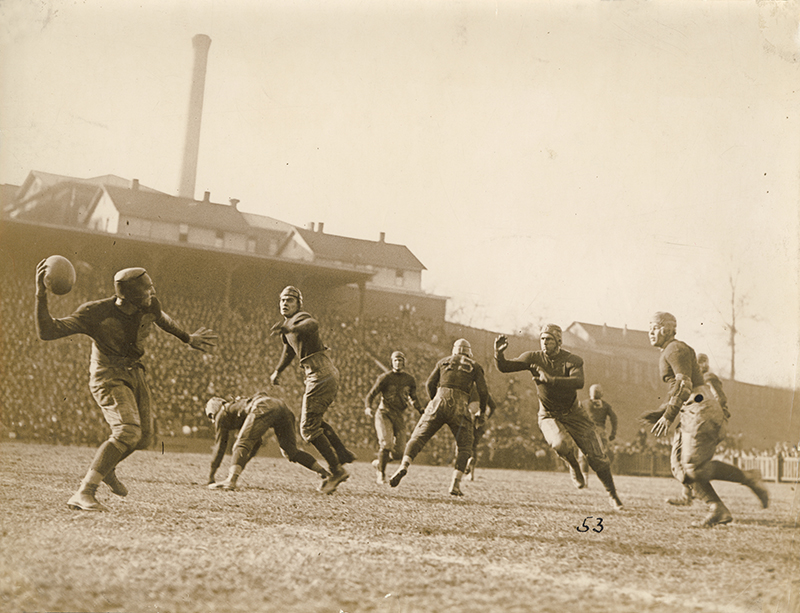 Georgia Tech Library via Wikipedia
Georgia Tech Library via Wikipedia
Passing techniques were different in those days. “Some players left their feet to make jump passes, while others tossed footballs underhanded or end over end,” writes Christopher Klein.
By today’s standards, the 1919 NU-Notre Dame game was a grind-it-out-on-the-ground, defensive struggle. But it didn’t look that way to fans at the time. In a 14-9 victory, Notre Dame completed five of eight passes for 114 yards. Nebraska, meanwhile, completed a single 10-yard pass out of seven attempts. Nebraska out-rushed Notre Dame 106 yards to 55. Newspaper reports agreed that Nebraska was superior in “straight football” (rushing) but was doomed by Notre Dame’s passing game.
“But for the forward pass,” the State Journal lamented, “Notre Dame would have made a sorry showing in matter of yardage gained and first downs.”
“Paint the football like a shamrock”
The game had a political context as well. The press didn’t agree as to what to call the Notre Dame players. Mostly they were called the “Catholics,” as the team had been known since the nineteenth century. But some reports call them “Hoosiers” and occasionally “Catholic Hoosiers.”
In 1919 Nebraska fans held a pre-game rally in which a law professor, Dr. Maxey, riled up the crowd with another description of Notre Dame players:
“These Notre Dame Irishmen are fighters raised in that part of Ireland where they do most fighting,” Maxey said. “My only suggestion would be to paint the football like a shamrock and then these Sinn Feiners won’t kick it so hard.”
This was more than traditional anti-Irish stereotypes. Maxey was referring to current events of the Irish revolutionary period. In 1919 the Irish republican party Sinn Féin founded a separate Irish parliament and declared independence from the United Kingdom; the Irish Republican Party began fighting a guerilla war against British forces.
Maxey was far from the only person to describe Notre Dame players as the Fighting Irish. Though it began as an insult, Notre Dame officially adopted the nickname in 1927.
In the meantime, anti-Catholicism continued to grow in the United States during the 1920s. In fact, things got so ugly in Lincoln in 1925 that Notre Dame refused to play there anymore.
Read more about Nebraska’s 1920s rivalry with Notre Dame.
And then… Neihardt?
The football scenes end abruptly at the 1:46 mark when John G. Neihardt appears on screen in a June 18, 1921 clip following his selection as Nebraska Poet Laureate. Neihardt delivered his laureate address at the Temple Theater on campus. (Read more about that here.) Other unidentified campus scenes round out the four-minute film.
And one more thing…
Black-and-white film doesn’t show it, but did you know that during the 1919 NU-Notre Dame game, one of the teams was wearing green jerseys?
And it wasn’t Notre Dame.
More about that in a forthcoming post.
Sources:
“All Set for Notre Dame,” Nebraska State Journal, Oct. 18, 1919, p. 3.
“Huskers Defeated by Narrow Margin,” Nebraska State Journal, Oct. 19, 1919, p. 7.
Christopher Klein, “How the Forward Pass Saved Football,” The History Channel, Dec. 17, 2021


